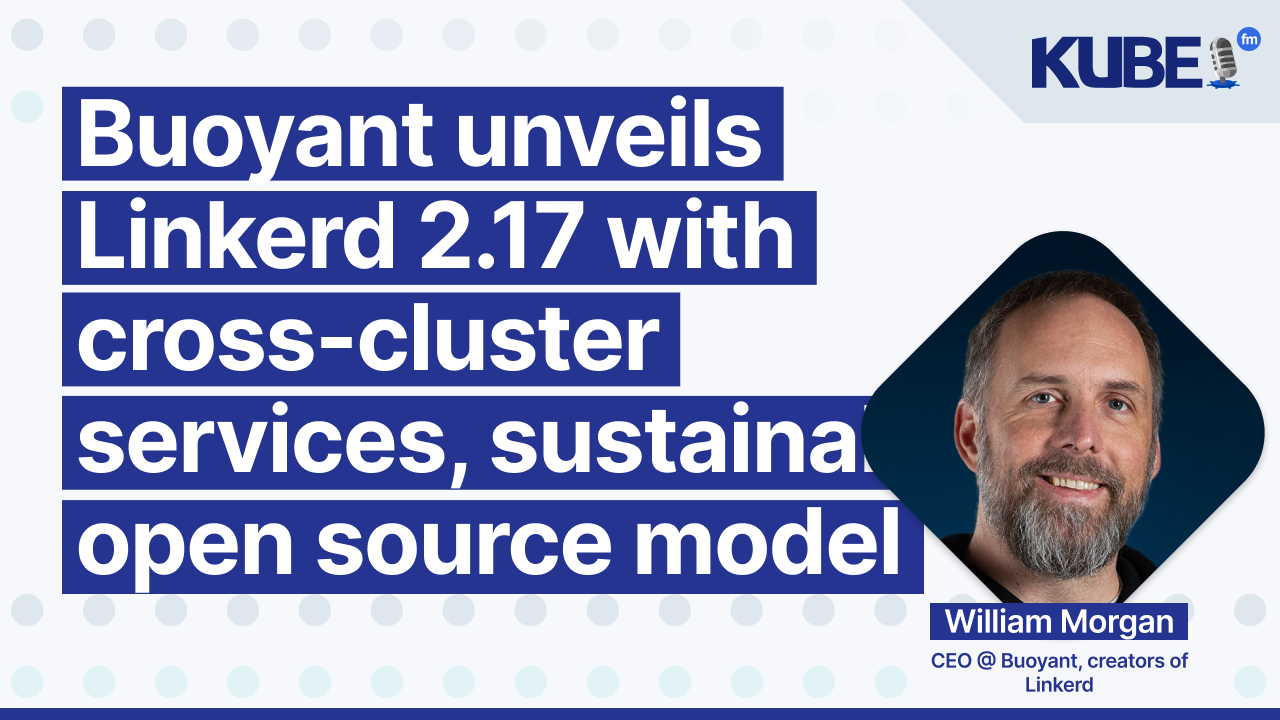Buoyant unveils Linkerd 2.17 with cross-cluster services, sustainable open source model
Dec 6, 2024
William Morgan, CEO of Buoyant and creator of Linkerd, announces two significant developments: the upcoming release of Linkerd 2.17 with new features like egress metrics and federated services and the "Project Sustainability" initiative.
This announcement is particularly significant for organizations relying on service mesh technology, as it addresses technical advancement and long-term project viability.
Morgan provides valuable insights into the often-overlooked aspect of open-source sustainability, explaining how commercial backing through Buoyant's enterprise distribution ensures the project's continued development while maintaining its core principle of simplicity in the complex service mesh landscape.
Relevant links
Transcription
Bart: First question, who are you? What's your role? Where do you work?
William: Hi there, I'm William Morgan, one of the creators of Linkerd. I'm also the CEO of Buoyant.
Bart: What do you want to share with us today?
William: So, a lot of exciting stuff is happening in Linkerd land. We're on the verge of announcing Linkerd 2.17, which adds egress metrics and control, rate limiting, and a very cool feature called federated services that allow you to make a union service over many clusters that all run the same service. We also recently announced Project Sustainability, which means Linkerd is going to be here forever.
Bart: What problem does Linkerd solve?
William: Linkerd solves three classes of problem: security problems, reliability problems, and observability problems. When you add Linkerd to your Kubernetes cluster, you get mutual TLS on by default, encryption of all data in transit between pods, a full host of observability functionality, including metrics and distributed tracing, and a whole set of reliability features, from retries and timeouts to rate limiting, all the way to failover across clusters.
Bart: Can you share a little bit about the context before and after this product announcement?
William: Before the announcement of Project Sustainability, Linkerd, like many projects, had an unclear relationship with its adopters. If you adopt an infrastructure project, are you guaranteed it's going to be around next year or in five years? With this project, we wanted to answer that question and provide a clear understanding that if you adopt Linkerd, you can rely on it being around for another five, ten, or even a hundred years.
Bart: Is Linkerd open source and part of the CNCF landscape?
William: Yes, it is. Linkerd is a graduated project, fully open source. All of the code is in a Linkerd GitHub repo under the Apache 2 license.
Bart: And what is Buoyant's business model?
William: Buoyant's business model is to sell an enterprise distribution of Linkerd. This distribution is everything in open-source Linkerd plus a couple of extra features. We have a very rigorous set of testing and validation that we do in customer-specific environments before it goes live. You get a hardened package with some enterprise-specific features, delivered with the same Linkerd goodness that you expect from the open-source project.
Bart: Who are your main competitors?
William: So, Linkerd lives in a very rich ecosystem with many different service mesh projects. Obviously, you've got Istio, and probably some other ones out there too. We all try to do the same thing, ultimately, which is to serve our platform adopter users and allow them to build a platform that's reliable, secure, and observable.
Bart: What differentiates Linkerd and Buoyant from the competition?
William: So, the biggest differentiation is that Linkerd is designed for simplicity, and we hold to that as strongly and strictly as we can. The service mesh space is unfortunately notorious for its complexity, and every time we add any kind of functionality or make any change to Linkerd, we try to take the user's perspective first and say, "If you are the end user, if you're deploying Linkerd, if you're on the hook or waking up at 3:00 AM when something goes wrong, how can we design this feature to make your life easier?"
Bart: What should we expect next from Linkerd and Buoyant?
William: We have a long and exciting roadmap ahead of us, ranging from Windows support to the addition of Ingress and API gateway support. We have a lot of exciting things that we're working on in the future.
Bart: William, what haven't we asked you that we should ask you?
William: I don't know.
Bart: What's the most controversial thing you said on KubeFM?
William: A lot of what I've been discussing at KubeFM today is the relationship between open source projects and the commercial entities that back them. My point is that it's very healthy for the community to understand the economics of the projects involved. Ultimately, every project here is operated on by paid maintainers, which means someone has to cover the costs. If you are adopting an open source project into your ecosystem and relying on it for your critical business infrastructure, then you need to understand not just the health of the project, but also the economic apparatus behind it that makes the project sustainable. That's exactly what we've tried to do with our announcement of Linkerd sustainability and Buoyant's new status as a profitable company.
Bart: What's been the reaction to that?
William: The reaction has actually been pretty positive. I was expecting pitchforks and torches, but I think everyone is starting to realize that these things are critical for open source projects. We can't ignore them, we can't put them off to the side, and we can't pretend that there's no value to talking about the economic apparatus behind a great project. We have to recognize that these are first-class concerns for anyone adopting an open source project.

